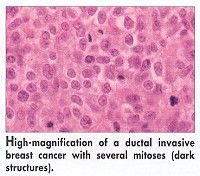Mitotic Activity Index IDs High-Risk Node-Negative Breast Cancer
SAN ANTONIO-The mitotic activity index (MAI), a measure of tumor cell proliferation, has been shown to be an independent prognostic factor for recurrence-free survival in breast cancer. It is being used in the Netherlands to select which node-negative patients require adjuvant chemotherapy, Elsken van der Wall, MD, PhD, said at the 23rd Annual San Antonio Breast Cancer Symposium.
SAN ANTONIOThe mitotic activity index (MAI), a measure of tumor cell proliferation, has been shown to be an independent prognostic factor for recurrence-free survival in breast cancer. It is being used in the Netherlands to select which node-negative patients require adjuvant chemotherapy, Elsken van der Wall, MD, PhD, said at the 23rd Annual San Antonio Breast Cancer Symposium.
Dr. van der Wall spoke in place of the scheduled speaker, Paul J. van Diest, MD, PhD, of the Department of Pathology, Free University Hospital, Amsterdam.
Determining MAI
The mitotic activity index (MAI) is determined by examining stained slides of tumor and counting the number of visible mitotic figures in the area containing the highest density of mitotic figures (see Figure).
The total number of mitotic figures counted in an area of 1.6 mm2 is the MAI. An MAI less than 10 is considered low while an MAI of 10 or more is considered high.
"The mitotic activity index is the best variable with which to select node-negative breast cancer patients for adjuvant chemotherapy," Dr. van der Wall said. It has a stronger prognostic significance in early invasive breast cancer among node-negative patients than other prognostic factors, including tumor size, she noted.
In the Netherlands, the MAI is being used to select which premenopausal node-negative patients with early invasive breast cancer are high risk and thus most likely to benefit from systemic adjuvant chemotherapy. "Treating all lymph-node-negative patients leads to substantial over-treatment," Dr. van der Wall said.
A consensus statement from the Dutch Society for Medical Oncology on Adjuvant Chemotherapy recommends that adjuvant chemotherapy be given only to high-risk patients, defined as those women who have an MAI equal to or greater than 10 (in an area of 1.6 mm2) (see box). Low-risk patients, defined as those with a tumor size of 1 to 3 cm and an MAI less than 10, are not recommended for adjuvant chemotherapy.
Study Results
Dr. van der Wall presented the results of an 8-year follow-up of 586 premenopausal node-negative patients from the Multicenter Mammary Carcinoma Project of the Department of Pathology at the Free University Hospital. The project was designed to prospectively evaluate the prognostic value of various features in 3,479 patients with invasive breast cancer.

None of the 586 patients received adjuvant chemotherapy. Eighty-five patients (14.5%) died of metastatic disease during the follow-up. The deaths were not evenly distributed among patients with low and high MAI, however.
Only 19 (6.1%) of 310 patients with a low MAI (less than 10) died of metastatic disease, compared with 66 (28.3%) of 233 patients with a high MAI (10 or more). The survival of patients with low MAI was comparably high in all subgroups, including patients with different tumor diameters and grades and differences in estrogen-receptor and proges-terone-receptor status.
Potential Problems
A number of potential problem areas have been identified with the MAI, including variations in counting protocol. These concerns have been addressed in many studies, Dr. van der Wall said. "Many of the studies were conducted in Europe, particularly Scandinavia, and they have shown that mitosis counting can be done in a highly reproducible way," she said.
In addition, intratumor heterogeneity is "easily handled" by a trained pathologist, she said. The ill effects of fixation delay on mitosis counting accuracy can be avoided so long as fixation is done within 24 hours.